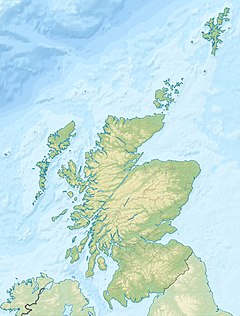
Falls of Foyers

| Falls of Foyers | |
|---|---|
 Falls of Foyers | |
 | |
| Location | Loch Ness, Highland, Scotland |
| Coordinates | 57°14′55″N 4°29′34″W / 57.24862°N 4.49269°W |
| Total height | 144 feet (44 m) |
The Falls of Foyers (Scottish Gaelic: Eas na Smùide, meaning the smoking falls) are two waterfalls on the River Foyers, which feeds Loch Ness, in Highland, Scotland. They are located on the lower portion of the River Foyers, and consist of the upper falls, with a drop of 46 feet (14 m) and the lower falls, which drop 98 feet (30 m).[1]

The falls were a popular destination for tourists using the pleasure steamers operating on Loch Ness, but in 1895, the North British Aluminium Company began building an aluminium smelting plant, which required large amounts of electricity. The hydro-electric station at the plant took large volumes of water from the River Foyers from an intake just above the falls, significantly reducing their flow. The plant was built without the need for Parliamentary approval, because the company bought the Lower Foyers estate, through which the river ran, and they were thus able to ignore the public outcry at the spoiling of an amenity. The works operated until 1967, with the original turbines which generated 3.75 MW remaining in use until the works closed.

The 1895 scheme had dammed Loch Garth and raised its level by 20 feet (6.1 m). Because it then joined Loch Farraline, the reservoir was renamed Loch Mhòr. This became the upper reservoir for a pumped-storage hydro-electric scheme when the newly closed works was taken over by the North of Scotland Hydro Electric Board. They installed a 5 MW turbine at the aluminium works, and constructed a tunnel from Loch Mhòr to feed a new power station located further to the north on the shore of Loch Ness. This has a capacity of 300 MW, and to preserve the amenity of the area, underground cables carry the power to a switching station some 3,000 feet (910 m) from the power station site. Further reductions to the flow over the falls have occurred as a result of diverting the River E into Loch Mhòr, and channelling most of the flow of the River Fechlin to it as well. Both formerly fed into the River Foyers, and hence the falls.

History
The falls influenced Robert Addams, a travelling lecturer in natural philosophy, to write a paper in 1834 about the motion aftereffect.[1] He observed that after watching the waterfall for a while, nearby rocks appeared to move upwards.[2]

Aluminium smelting
The flow over the falls has been much reduced since 1895 when North British Aluminium Company built an aluminium smelting plant on the shore of Loch Ness which was powered by electricity generated by the river. Artist Mary Rose Hill Burton, who was active in the unsuccessful resistance against the smelting plant, made many drawings and paintings of the falls before the plant was built, to capture the landscape in nature before it was lost.[3][4]

Aluminium was first recognised in the early 1800s, and processes for extracting it from Bauxite ore were developed during the nineteenth century. The most promising was the Heroult-Hall process, separately developed by P T L Heroult in France and C M Hall in America in 1886-1887, but it required large amounts of electricity. The rights to using the process in Britain were obtained by the British Aluminium Company, which was formed in 1894. To produce a ton of aluminium required around 24 MWh of power, and the idea of obtaining cheap hydro-electricity to produce it was suggested. The company identified the Falls of Foyers as a possible site, and bought the Lower Foyers estate, covering some 8,000 acres (32 km2), together with water rights from neighbouring areas. This allowed them to create a hydro-electric scheme without needing to obtain Parliamentary approval, and to ignore public opposition to the effects it would have on local amenities. The River Foyers ran through a gorge to the almost vertical Lower Falls, which was a beauty spot, and was a stopping point for tourists using the MacBrayne pleasure steamers running along the Caledonian Canal from Fort William to Inverness.[5]

Construction began in 1895. Loch Garth was modified by a concrete and masonry dam at its south-western end, together with an earth embankment.[6] The concrete section is 690 feet (210 m) long and around 23 feet (7 m) tall,[7] or possibly 760 feet (232 m) long and around 30 feet (9 m) tall.[8] The dam raised the water level of Loch Garth by 20 feet (6.1 m), resulting in it joining Loch Farraline, and the combined storage reservoir, which was 4.5 miles (7.2 km) long, was renamed Loch Mhòr. Water from the reservoir was conveyed along the original course of the River Foyers to the top of the Upper Falls of Foyers. From there a tunnel was cut through solid rock for 0.5 miles (0.80 km) and the water continued through cast iron pipes to the generating station. The pipes were 30 inches (76 cm) in diameter, and were laid in a trench, to be covered with sand. This provided a head of 350 feet (110 m) to the turbines, and although there was some debate as to whether cast iron pipes could withstand such pressure, no issues were experienced. The water drove five Girard turbines connected to Oerlikon direct current generators, which could produce a total of 3.75 MW. This was sufficient for the production of aluminium, and some 200 tons per year were produced from June 1896. It was a new product, and with production exceeding demand, the power was also used to produce calcium carbide, and experiments were carried out to manufacture ferro-silicon, carborundum, cerium, magnesium, and precious stones.[6]

The plant at Foyers steadily improved in efficiency, as the Heroult-Hall process was refined, and by 1904, world demand for aluminium had increased sufficiently that production of calcium carbide ceased, and the plant only produced aluminium.[6] However, larger plants built subsequently at Kinlochleven and Fort William were more efficient, and from 1954, the plant was used to refine aluminium produced at those sites, by remelting it and removing impurities, to produce "super purity" aluminium. This eventually became uneconomic, and the plant shut in 1967. The Girard vertical shaft Pelton wheels, which had been installed in 1896 to provide power at 65 volts and 8000 amps, were used until the plant closed.[9]

Hydroelectric power
Falls of Foyers hydro-electric scheme | ||||||||||||||||||||||||||||||||||||||||||||||||||||||||||||||||||||||||||||||||||||||||||||||||||||||||||||||||||||
|---|---|---|---|---|---|---|---|---|---|---|---|---|---|---|---|---|---|---|---|---|---|---|---|---|---|---|---|---|---|---|---|---|---|---|---|---|---|---|---|---|---|---|---|---|---|---|---|---|---|---|---|---|---|---|---|---|---|---|---|---|---|---|---|---|---|---|---|---|---|---|---|---|---|---|---|---|---|---|---|---|---|---|---|---|---|---|---|---|---|---|---|---|---|---|---|---|---|---|---|---|---|---|---|---|---|---|---|---|---|---|---|---|---|---|---|---|
| ||||||||||||||||||||||||||||||||||||||||||||||||||||||||||||||||||||||||||||||||||||||||||||||||||||||||||||||||||||
The site was acquired by the North of Scotland Hydro Electric Board soon after the aluminium plant closed in 1967. The Girard turbines were replaced by a 5MW generator located in the main building.[9]

Angus Fulton had been the Chief Civil and Hydraulic Engineer for the North of Scotland Hydro Electric Board almost from its inception.[10] He had considered that Foyers would be a suitable site for a 60MW conventional hydroelectric scheme, but following the completion of the Hunterston A nuclear power station, the Joint Planning Committee that advised both the Board and the South of Scotland Electricity Board, had recommended that a 300MW pumped storage scheme was needed next. By that time Fulton had been succeeded by K R Vernon, an engineer with wide experience, that included working on the construction of another pumped storage scheme at Cruachan. He was an enthusiastic advocate for pumped storage schemes, as they complemented large thermal power stations such as Hunterston.[11]

Plans for the Foyers scheme were published in 1968, and they were the fortieth construction scheme that the Board had promoted. Loch Mhòr would be the upper reservoir and Loch Ness the lower reservoir. The catchment for Loch Mhòr was about 30 square miles (78 km2), but this would be increased to 80 square miles (210 km2) by diverting most of the flow of the River Fechlin and the River E into the loch. Like Cruachan, the system would be a hybrid, where about 25 percent of its output would be derived from water flowing from the catchment into Loch Ness, and the remainder would be from the pumped storage element. The project was estimated to cost about £106 million, and made good economic sense, since the cost per kW installed was £35.2, compared to around £50 for a thermal station of a similar size. The plans were laid before Parliament in February 1969 and approved in April.[12]

The rock between Loch Mhòr and Loch Ness is heavily fractured, making tunnelling difficult, and there was only one place where the ground was sufficiently high to accommodate a surge shaft. This was at Tom an Eig, and by following a curved route, the low pressure tunnel could be driven through Foyers granite from Loch Mhòr to the surge shaft. However, the route was bisected by the Gleann Liath, a small lower lying valley, and because the quality of rock was so poor, the pipeline ran off the surface for a short distance. This provided two additional work faces from which tunnelling could be carried out. The low pressure tunnel was 9,400 feet (2,900 m) long. From the surge shaft, a 24-foot (7.3 m) tunnel was excavated, which fed two steel lined tunnels to supply the turbines. These were situated at the bottom of elliptical shafts which are 165 feet (50.2 m) deep, an arrangement that maintained the scenic integrity of the area[13] and complied with the planning conditions that the outlet should be at least 115 feet (35 m) below the surface of Loch Ness.[14]


Edmund Nuttall Ltd won the contract for the surge shaft, the high pressure tunnels, the power house and lower control works. The contract for the low pressure tunnel was awarded to Duncan Logan Construction, but they went bankrupt after six months on site, and Nuttall's took over this part of the project as well. The reversible turbines were supplied by Boving and Company, at a cost of nearly £2 million. The surge shaft was nearly 300 feet (91 m) tall and 61 feet (19 m) in diameter when completed. It was lined with concrete, which was achieved in a single pour by working 24 hours a day for 21 days, and using a hydraulically operated climbing shutter.[15] Initial plans for routing the 275kV power lines away from the station were altered after there were objections to the route, and following a public enquiry, the switching station was located some 3,000 feet (910 m) further along Loch Ness, with the cables buried underground between the power station and the switching station.[16]

The new power station is situated on the east bank of Loch Ness, to the north of the aluminium smelter, and was formally opened in April 1975. The scheme has a capacity of 305 megawatts and comprises two 150 MW generating sets located at the bottom of elliptical shafts, plus the 5MW generators at the Falls of Foyers station. The turbines are controlled remotely from a control centre in Perth, and when there is a sudden increase in demand for electricity, the plant can start generating 300 MW within 30 seconds, using 200 tonnes of water per second. At periods of low demand, the turbines are run in reverse, taking power from the grid to pump water from Loch Ness back into Loch Mhòr, ready for the next period of high demand. In order to allow back pumping, water for the power station no longer uses the course of the river, but is fed through 2 miles (3.2 km) of pipes and tunnels which run to the station from Loch Mhòr.[17]

When completed, the final cost of the project was nearly twice the original estimate, at £20.2 million. However, 60 percent of the increase was due to inflation, and much of the rest was due to the extremely difficult geology of the area, which lies in the shatter zone of the Great Glen Fault. The scheme proved to be the last of the schemes carried out by the North of Scotland Hydro Electric Board.[18]

Maintenance
The low pressure tunnel from Loch Mhòr to the surge chamber is D-shaped and 23 feet (7 m) in diameter. From the surge chamber, the water fills a vertical concrete shaft which is 367 feet (112 m) deep and the same diameter as the low pressure tunnel. At the bottom, it turns through a right angle, and continues as a concrete tunnel with a steel lining. This then splits into two smaller tunnels, again steel lined, which taper down to 10 feet (3 m) at the inlet valves for the turbines. In 2002, some of the steel lining separated from the concrete in one of the tunnels, on the final section 160 feet (49 m) below the level of Loch Ness. Engineers from Kvaerner Markham of Sheffield, England cut away the damaged steelwork and fitted redesigned linings, which had to be welded in situ, before 400 anchor bolts were used to attach them to the concrete.[19]

The generator sets at Foyers produce power at 18kV, which is stepped up to 275kV at the station, and is connected to the switching station by an underground oil-filled cable.[20] There are two transformers, one of which was manufactured in 1982, and a second which was installed in 1991[21] after partial failure of the first one. By 2019, the original transformer was in need of replacement, and a decision was taken to rationalise the system, including the replacement of the oil-filled cable to the switching station, as it is the only one left in the Scottish transmission system.[22] The proposed solution will involve building a new transformer station offline, just outside the existing power station compound.[23]

Heritage
The main building for the aluminium smelter was probably designed by Cameron Burnett and erected in 1895-96. It consists of eight crow-stepped gables, behind which is a long shed. It has a corrugated iron roof, and the end walls are pierced by pairs of round-headed windows. Each of the eight ridges has a louvered saddle-back vent running along its length. It is a Grade A listed structure, and has been listed because the powerhouse was the first use of large scale hydroelectric power for industrial purposes in Scotland.[24]

The dam at Loch Mhòr was built at the same time. It was made of concrete, masonry and rammed earth, and consists of two sections. The north-west wall was subsequently reinforced with additional concrete, while the control tower is crenellated, reflecting the style of the smelter. The control gear for the sluice gates is original.[25] The intake for the original turbines consists of a D-shaped structure on the River Foyers just above the Upper Falls. It is not quite in original condition, as metal screens and railings were added in the late 20th century.[26]

Notes
- ^
 This article incorporates text from a publication now in the public domain: Wood, James, ed. (1907). "Foyers, Fall of". The Nuttall Encyclopædia. London and New York: Frederick Warne.
This article incorporates text from a publication now in the public domain: Wood, James, ed. (1907). "Foyers, Fall of". The Nuttall Encyclopædia. London and New York: Frederick Warne. - ^ MAE Waterfalls
References
- ^ "Falls of Foyers, Great Glen: The Smoking Falls". Scottish Geology Trust. Archived from the original on 18 May 2022.
- ^ Nikolova & Wade 2019.
- ^ Janice Helland, "Artistic Advocate: Mary Rose Hill Burton and the Falls of Foyers," Scottish Economic and Social History 17(November 1997): 127-147.
- ^ James Britten, "The Falls of Foyers," Nature Notes: The Selborne Society's Magazine 6(69)(September 1895): p. 162.
- ^ Payne 1988, pp. 4–5.
- ^ a b c Payne 1988, p. 5.
- ^ "Foyers hydro scheme". SSE Renewables. Archived from the original on 4 February 2023.
- ^ "Foyers Open Day" (PDF). Scottish Hydro. Archived (PDF) from the original on 24 June 2022.
- ^ a b "Foyers and Aluminium". South Loch Ness Heritage Group. 2023. Archived from the original on 26 July 2021.
- ^ Payne 1988, p. 53.
- ^ Payne 1988, pp. 241–242.
- ^ Payne 1988, p. 242.
- ^ Payne 1988, pp. 242–245.
- ^ SSE 2005, p. 16.
- ^ Payne 1988, pp. 245–246.
- ^ Payne 1988, p. 246.
- ^ "Foyers". Scottish and Southern Energy. Archived from the original on 5 August 2017. Retrieved 11 August 2018.
- ^ Payne 1988, p. 247.
- ^ "A monster repair job". International Water Power. 4 November 2002. Archived from the original on 3 October 2022.
- ^ SSEN 2020, p. 2.
- ^ SSEN 2020, p. 6.
- ^ SSEN 2020, p. 7.
- ^ SSEN 2020, p. 20.
- ^ Historic Environment Scotland. "Foyers Hydroelectric Power Scheme, Former Aluminium Smelter, Power House and Smelter (Category A Listed Building) (LB1880)".
- ^ Historic Environment Scotland. "Foyers Hydroelectric Power Scheme and Former Aluminium Smelter, Loch Mhor Dam (Category C Listed Building) (LB51700)".
- ^ Historic Environment Scotland. "Foyers Hydroelectric Power Scheme and Former Aluminium Smelter, River Tarff(sic) Intake (Category C Listed Building) (LB51701)".
Bibliography
- Nikolova, Niia; Wade, Nick (9 June 2019). "Waterfall illusion: Still objects seem to move". EarthSky. Archived from the original on 8 September 2022.
- Payne, Peter L (1988). The Hydro. Aberdeen University Press. ISBN 978-0-08-036584-8.
- SSE (2005). "Power from the Glens - Neart nan Gleann". Scottish and Southern Energy. Archived from the original on 27 April 2023.
- SSEN (2020). "Foyers Substation Works Engineering Justification Paper" (PDF). Scottish and Southern Electricity Networks. Archived (PDF) from the original on 27 April 2023.
External links
![]() Media related to Fall of Foyers at Wikimedia Commons
Media related to Fall of Foyers at Wikimedia Commons

![]() Media related to Loch Mhòr at Wikimedia Commons
Media related to Loch Mhòr at Wikimedia Commons

See what we do next...
OR
By submitting your email or phone number, you're giving mschf permission to send you email and/or recurring marketing texts. Data rates may apply. Text stop to cancel, help for help.
Success: You're subscribed now !

